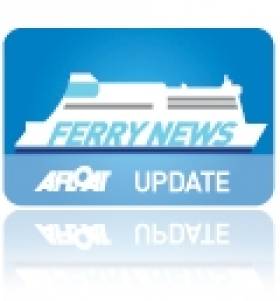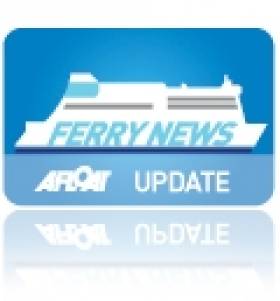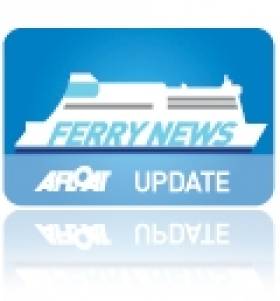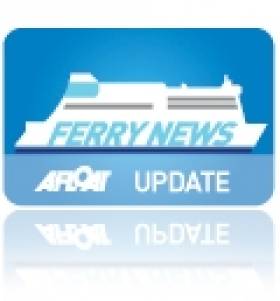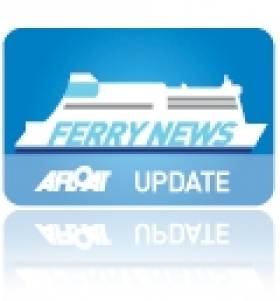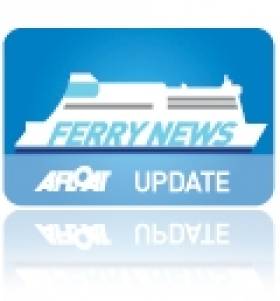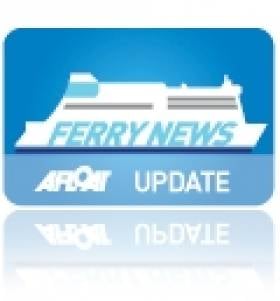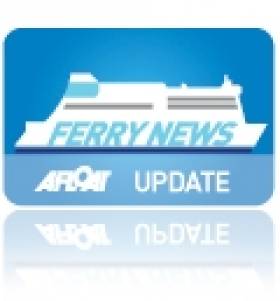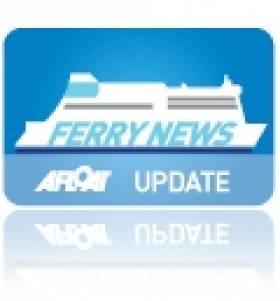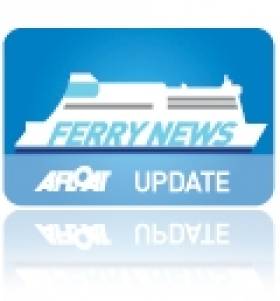Displaying items by tag: RosslareCherbourg
Oscar Reopens French Route Season
#FrenchRoute-Irish Ferries set sail for France today on board cruiseferry Oscar Wilde, which launches the 2013 season with a night-time departure on the Rosslare-Cherbourg route.
Irish Ferries are currently offering a fare from €99 car & driver & reserved seat. The price includes all taxes if booked at least 10 days in advance of travel date.
Oscar Wilde made her debut on the continental service in 2007, she has extensive passenger facilities and a wide choice of cabin accommodation, having served in Scandinavian waters with Color Line.
She recently returned to Rosslare, fresh from annual maintenance carried out at the Cammell Laird dry-dock facility in Birkenhead. In May the Rosslare-Roscoff route resumes a peak-season operated service.
French Ferry Sailings Set to Resume Service
#FERRY TO RESUME – Services on Celtic Link Ferries Rosslare-Cherbourg route as previously reported on Afloat.ie are scheduled to resume with tomorrow (20 November) night's sailing departing 21.30hrs.
According to the ferry operator, the ro-pax ferry Celtic Horizon will be operating to a reduced capacity, however the sailing will mark the return of standard sailing times.
Due to the restrictions in place any passenger with special needs are requested to contact CLF on 053 916 2688 (Ireland) or 02 33 43 23 87 (France) and for further information visit www.celticlinkferries.com
No Ferry Sailing due to Mooring Issue in Cherbourg
#NO FERRY SAILING – Due to a mooring issue that took place in Cherbourg, there will be no sailing today (18 November) on Celtic Link Ferries 19.00hr departure from Cherbourg to Rosslare.
According to the operator's website, yesterday's outward sailing from Rosslare was also cancelled and that passengers intending to travel today will also be looked after on other sailings. In the meantime the ro-pax vessel remains berthed at Rosslare Europort.
To keep updated of further developments passengers are requested to consult the operators website HERE and by contacting CLF on 053 916 2688 (Ireland) or 02 33 43 23 87 (France).
A Year on the Horizon for Celtic Link's Ro-Pax Ferry
#CELTIC LINK - The Celtic Horizon, the 27,522 tonnes ro-pax ferry this week celebrates her first year in service on Celtic Link Ferries Rosslare-Cherbourg route, writes Jehan Ashmore.
According to the Celtic Link they have had a 'resoundingly successful inaugural year with the Celtic Horizon'. The Co. Wexford based operator saw double digit-growth in the number of tourist passengers sailing on the 17 hour route.
Celtic Link envisage that this growth will continue in 2013 and as the only year-round operator between Ireland and France. On the freight front, strong performance has been recorded despite the turbulent economic conditions in which the company has claimed to have performed in line with yearly forecasts.
The 1000 passenger capacity ferry, with space for 200 cars and up to 120 freight vehicles, completed her first round trip voyage last October, having been chartered by CLF for a five-year term contract. On board the 186m vessel facilities include 110 cabins, a bar, restaurant, lounges, cinema, shop and wi-fi connectivity.
Celtic Horizon was built in 2006 by Cantiere Navala Visentini, Portoviro, in Italy and she retains her port registry of Bari. As the Cartour Beta, she began her career serving routes between Naples and Sicily for Caronte & Tourist (C&T) until her charter ceased late last summer.
Last September, the vessel was berthed in Palermo, in advance of her four-day delivery voyage to Ireland. The voyage set a course that saw her offshore of the Algerian coast and before leaving the Mediterranean, an en-route call was made to Gibraltar to load bunkers, until she finally reached Rosslare Harbour.
She has more passenger deck space compared to her predecessor, Norman Voyager, which likewise was built of the same overall ro-pax design of the Italian shipbuilder. A notable and novel feature is the escalator which whisks passengers from the vehicle decks to the main passenger deck.
Got that Friday Ferry Feeling….Like It
#FRIDAY FERRY FREEBIES – Celtic Link Ferries have launched a new 'Friday Ferry Freebies' campaign where they are giving away the chance of winning a return trip to France on the Rosslare-Cherbourg route, writes Jehan Ashmore.
The prize is for a round-trip that includes two adults travelling in a car or campervan with cabin in each direction, subject to availability. The offer is valid during May, September, October, November and December 2012.
For a chance to win the Wexford based operator ask you to like and share on their Facebook page by visiting www.facebook.com/celticlink. The first winner is to announced this afternoon.
This is the first high-season that the company's Celtic Horizon will be operating the French route since the ro-pax ferry was launched last October.
Calling Cherbourg: All Things Nauting
#FERRY SAILS – Ferry passengers perhaps on a mini-wine break cruise between Rosslare-Cherbourg may be taking a detour to the Cherbourg Nauting Boat Show which is been held this weekend, writes Jehan Ashmore.
Both Celtic Link Ferries and Irish Ferries operate on the continental route to the man-made Norman port originally constructed by Napoleon. The present day bustling town-centre of Cherbourg-Octeville to give its full name is close to the large 1500-plus berth marina at the Port Chantereyne which is hosting the show.
Those attending can buy and sell new and second-hand boats and where there will be exhibitors attending the three-day show which started yesterday. Activities include scuba-diving, dry surf, stand-up-paddle and model-boats on a dedicated pool.
In addition there is a guided-tour on a racing-boat commented by its skipper Eric D'Hooghe from the Figaro Race. Also making an appearance is the French rower Rémy Alnet who will be there to talk about his trans-Atlantic races.
Also on a related note is the La Cité de la Mer which is a museum situated in the former trans-Atlantic liner passenger terminal used during the so called golden era. The history of these liners is recalled in the museum and of course includes the RMS Titanic and the French Line's famous France which as the Norway made a once off anchorage call outside Dun Laoghaire Harbour.
In addition there are displays of submarines including the decomissioned French Navy nuclear-powered submarine Le Redoutable which is located in an adjoining dry-dock.
- Ferry news
- Cherbourg Nauting
- Napoleon Port of Cherbourg
- Port de Cherbourg
- Cite de la Mer
- CherbourgOcteville
- RosslareCherbourg
- Port Chantereyne marina
- Celtic Liink Ferries
- Irish Ferries
- WineBreak Mini Cruises
- Scubadiving
- DrySurfing
- standup paddle
- SUP
- ModelBoats
- New Boats
- SecondHand Boats
- TransAtlantic Liners
- Le Redoutable submarine
- French Navy
- RMS Titanic
- French Line's France
- Cruiseship Norway
- Dun Laoghaire Harbour
- Dun Laoghaire Harbour cruise liner calls
- Dun Laoghaire Harbour Norway anchorage call
- Cruiseships
- Cruiseliners
- Figaro Race
- Eric D'Hooghe
- French rower Remy Alnet
- Remy Alnet
- La Cité de la Mer
Celtic Horizon Officially Enters Service
She replaces the Norman Voyager which too was built by Visentini. The 186m ro-pax vessel last week arrived from the Mediterranean (to read more click HERE) and will be chartered to CLF for a five-year term contract. Overall she has a larger passenger deck compared to her predecessor, with a restaurant, two bars, pull-man lounges, a cinema, children's play-area, game-zone and kiosk-shop.
In addition to her 130 cabins she has five vehicle decks for 200 cars and a total 2,500 lane freight metres equating to around 110-trucks. An unusual feature is an escalator that whisks passengers from the car-decks up to the passenger deck.
Prior to the event, Celtic Horizon had arrived into the Wexford port. She had completed her maiden 'Irish' round-trip commercial voyage over the weekend from Cherbourg during stormy seas under the command of Captain Richard Collins.
Last year CLF handled 60,000 passengers and 50,000 vehicles between tourist vehicles and freight business. This year they are expecting an increase of passenger traffic of around 30%. The company are the only ferry operator running year-round sailings on the Irish –French routes.
CLF took over the Rosslare-Cherbourg route from P&O in 2005. With the Celtic Horizon they will continue providing three-round trips per week on the route which transports passengers, tourist cars, camper-vans, freight trucks including livestock and the importation of French manufactured new trade-cars.
Wexford Welcomes New Irish-French Ferry Celtic Horizon
The changeover of vessels coincides with the existing Rosslare-Cherbourg sailing schedule of three round-trips per week, noting there are no sailings from the Wexford port on Mondays. Celtic Horizon is due to be introduced with her maiden 'Irish' voyage on Tuesday night, departing Rosslare at 21.30hrs. On the following Monday she is to be officially launched onto the service.
Celtic Horizon will boost capacity on the French route, offering a wider choice of restaurants, bars and a children's play-room. She can carry 840 passengers, 200 cars and 120 freight vehicles. The 186m ferry is from a ro-pax series (including Norman Voyager) designed and built by Cantiere Navala Visentini based in Portoviro, outside Venice.
During her five-day repositioning route from the Mediterranean, Celtic Horizon made an en-route call to Gibralter, anchoring off the British colony on Thursday. Another of the same Visentini ro-pax class vessels, Cartour Epilson is believed to have taken over Celtic Horizon, formerly named Cartour Beta when she served her last season between Termini Imerese in Sicily to Salerno while on charter to C&T.
CLF will be the only ferry operator running services to France, between 2 January -19 February 2012, as Irish Ferries, which also operates on the Rosslare-Cherbourg route, will be taking off Oscar Wilde for annual dry-docking. For schedules click HERE.
In addition there will be no sailings between Cork-Roscoff, as Brittany Ferries final sailing for this year is 29 October, served by 'flagship' Pont-Aven. The 2012 season starts in late March.
New Celtic Link Ferry on Re-Positioning Voyage off Africa
CLF are to charter Celtic Horizon for a five-years and the 25-knot capable vessel will takeover the existing thrice-weekly round trip sailing schedule from ro-pax Norman Voyager. Between 2 January -19 February 2012, CLF will be the only continental ferry operator running services as rivals Irish Ferries will be taking their cruiseferry Oscar Wilde for annual dry-docking. To read more click HERE.
In addition there will be no sailings between Cork-Roscoff, as operators Brittany Ferries last sailing for this year is 29 October, served by 'flagship' Pont-Aven. The 2012 season starts in late March.
Celtic Horizon is the first vessel to be named with a 'Celtic' prefix of part of their ferry operations, since the company brought European Diplomat from former route operators P&O (Irish Sea) in 2005. The freight-ferry renamed Diplomat, served Celtic Link Ferries until 2009. Since then she has been on charter in the Caribbean until this summer when she was sold to the breakers in Alang, India. To read more click HERE.
As for Celtic Horizon, she was built in 2006 and spent her last season this year as Cartour Beta while on charter to C&T's routes between Naples and Sicily, to read more click HERE. The 186m ro-pax is believed to be heading for Gibraltar while en-route to Rosslare.
During her Irish service, she will maintain Italian registry of Bari whereas her predecessor Norman Voyager changes flags from the UK to that of the French tricolour. Both vessels are similar as they share a ro-pax design which has proved popular for Italian shipbuilders Cantieri Navali Visentini.
The 2008 built Norman Voyager of 26,904grt is to revert to LD Lines operation and used on their 'Motorways of the Seas' St. Nazaire-Gijon service, though she was to enter on the Marseilles-Tunis route. Her new role on the Franco-Iberian route sees the replacement of Norman Asturias.
Overnight Sailing Marks End-of-Seasonal French Route
The former Scandinavian cruiserferry was built in 1987 to serve on Color Line's Oslo-Kiel route as their Kronprins Harald. In 2007 she was sold to start French sailings and at 31,914grt, she is the largest cruiseferry to operate under Irish Ferries continental routes. Passenger capacity is just shy of 1,500 and cars total 730 in addiition space for around 90 freight vehicles. For a virtual tour of the cruiseferry's on board facilities and exterior deck views click HERE.
Winter sailings will run to the end of the year with a final departure on 30th December outbound and returning from France on 2nd January 2012. Thereafter there will be a no sailings as the cruiseferry is to undergo annual dry-docking before resuming sailings. The first sailing from Ireland is 19th February and the corresponding return sailing from France is 21st February. To keep up-to-date with sailing schedules click HERE.


























